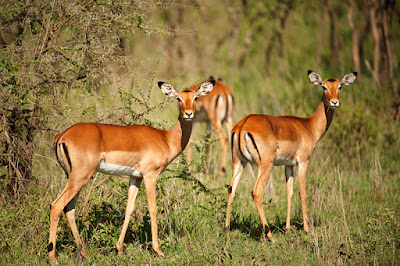The impala is a moderately sized African antelope. The sole member of the genus Aepyceros, this bovid was first described by German zoologist Martin Hinrich Carl Lichtenstein in 1812. Two subspecies are recognised. Impala stand nearly 70–90 cm (28–35 in) at the shoulder and weigh 40–75 kg (88–165 lb). This antelope features a glossy, reddish brown coat. Only the males have the characteristic slender, lyre-shaped horns, which can grow to be 45–92 cm (18–36 in) long.
Impala Kampala city derives its name from here ( Kampala is the capital city of Uganda )
The impala inhabits savanna grasslands and woodlands in close proximity to water sources. It is a mixed forager, whose diet consists of grasses, forbs, monocots, dicots and foliage. It switches between grazing and browsing depending on the season and habitat. Water is an essential requirement. Impala are fast runners and are known for their leaping ability, reaching heights up to 3 m (9.8 ft). They communicate using a variety of unique visual and vocal cues. There are three distinct social groups during the wet season: the female herds, the bachelor herds and the territorial males. The mating season is the three-week-long period toward the end of the wet season in May. A single fawn is born after a gestational period of about six to seven months. The fawn remains with its mother for four to six months, after which it joins juvenile groups.
The impala is native to Angola, Botswana, Kenya, Malawi, Mozambique, Namibia, Rwanda, South Africa, Swaziland, Tanzania, Uganda, Zambia and Zimbabwe. Regionally extinct in Burundi, it has been introduced in two protected areas of Gabon. The black-faced impala is confined to Kaokoland (Namibia) and southwestern Angola. The common impala has been widely introduced in southern Africa. Though there are no major threats to the survival of the species as a whole, poaching and natural calamities have significantly contributed to the decline of the black-faced subspecies. While the common impala has been listed as of Least Concern by the International Union for Conservation of Nature (IUCN), the black-faced has been rated as Vulnerable.
Impala are known for their great leaping ability, reaching heights up to 3 m (9.8 ft).
Quality, Affordable Gorilla Trekking and Wildlife Adventure in Uganda & Rwanda
For Booking Email us on gorillatourbooking@gmail.com or info@gorillatourbooking.com
Call us for booking on +256 704 63 50 44 ,+256 777 50 61 26
For Booking Email us on gorillatourbooking@gmail.com or info@gorillatourbooking.com
Call us for booking on +256 704 63 50 44 ,+256 777 50 61 26
- Home
- Gorilla Trips
- Uganda Safaris
- 1 Day Kampala Tour, One Day Kampala safari visit by Gorilla Tours Booking
- Family Adventure Holiday in Uganda | Uganda Eco Tours
- 1 Day Lake Mburo National Park Wildlife Safari Tour
- 1 Day Ngamba Island Excursion
- 2 day Luxury Lake Mburo Safari - a Taste of African Wild
- Mabira Rainforest 2 Day Luxury Safari
- 3 Days Gorilla Tracking Tour
- Budget Wildlife Safari Queen Elizabeth 2015
- Gorilla Trekking Holiday Bwindi Impenetrable Park Uganda 5 Days and 4 Nights
- --3 Days Kibale Chimpanzee Safari
- 10 Day Uganda Safari (midrange)
- Uganda National Park
- Rwanda Safaris
- Rwanda Gorilla Tracking and Trekking Wildlife Tour to Parc Nationale Des Volcanoes
- 3 Day Gorilla safari in Rwanda, Visit Dian Fossey
- -3 Days Gorilla Safari Genocide memorial tour - Rwanda Gorilla
- 4 Days Gorilla tracking Rwanda/Akagera Wildlife Tour
- 4 Days Uganda Gorilla Safari - Double gorilla tracking Adventure
- 4 Days Volcanoes safaris gorilla trekking to Parc Nationale Des Volcanoes
- Rwanda Cultural Safaris - Cultural Heritage and Values in Rwanda
- Rwanda National Parks
- Fishing Safaris
- Tourist Information
- Accomodation Uganda and Rwanda
- Rwanda Visa Application
- Gorilla Permits in Uganda and Rwanda
- Student safari in Uganda
- What To Wear On Safari In Africa
- Picking the Safari Tour Company for my upcoming Safari in Uganda – Rwanda
- What To Pack On A Safari To Africa
- Rwanda's Cultural and Community based tourism
- More Information
- Our Blog
- FAQ
- About us
- Contact us















0 comments:
Post a Comment